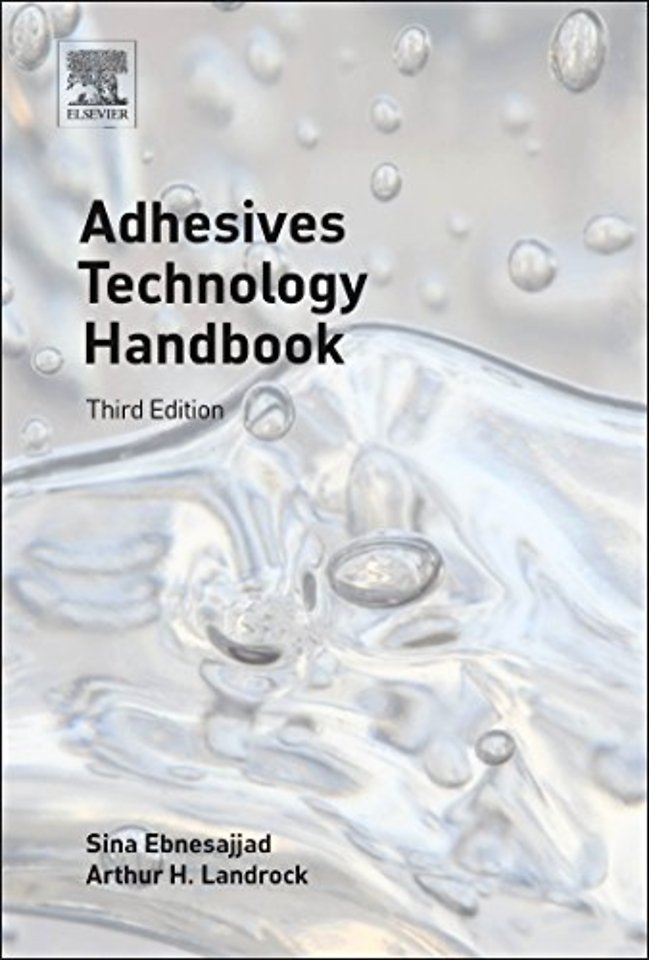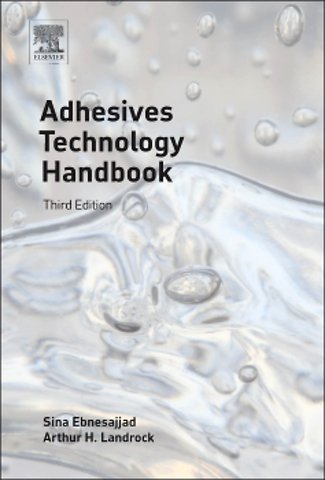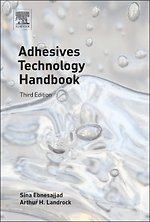Adhesives Technology Handbook
Samenvatting
Key Features
- Provides practitioners of adhesion technology with a complete guide to bonding materials successfully.
- Covers the whole range of commonly used substrates including plastics, metals, elastomers and ceramics, explaining basic principles and describing common materials and application techniques.
- Introduces the range of commercially available adhesives and the selection process alongside the science and technology of adhesion.
Covering a wide range of industrial applications across sectors including medical applications, automotive/aerospace, packaging, electronics, and consumer goods, this book provides a complete guide to the selection of adhesives, methods of use, industrial applications, and the fundamentals of adhesion. Dr Ebnesajjad examines the selection of adhesives and adhesion methods and challenges for all major groups of substrate including plastics (thermosets and thermoplastics), elastomers, metals, ceramics and composite materials. His practical guidance covers joint design and durability, application methods, test methods and troubleshooting techniques. The science and technology of adhesion, and the principles of adhesive bonding are explained in a way that enhances the reader's understanding of the fundamentals that underpin the successful use and design of adhesives.
The third edition has been updated throughout to include recent developments in the industry, with new sections covering technological advances such as nanotechnology, micro adhesion systems, and the replacement of toxic chromate technology.
Readership. Adhesive manufacturers and consumers, processors, fabricators, equipment assemblers and part end-users. Practitioners in most industry segments such as medicine, dentistry, electronics, and automotive/aerospace.
Specificaties
Inhoudsopgave
Preface to Second Edition
Acknowledgments
1. Introduction and Adhesion Theories
1.1 Definition of Adhesives and Adhesive Bonding
1.2 Functions of Adhesives
1.3 Classification of Adhesives
1.4 Advantages and Disadvantages of Joining Using Adhesives
1.5 Requirements of a Good Bond
1.6 Introduction to Theories of Adhesion
1.7 Definition of Failure Modes
1.8 Mechanisms of Bond Failure
References
2. Surface Tension and Its Measurement
2.1 Introduction
2.2 What is an Interface?
2.3 Surface Tension
2.4 Surface Free Energy
2.5 Contact Angle (Young’s Equation)
2.6 Effect of Temperature on Surface Tension
2.7 Surface Tension Measurement
References
3. Material Surface Preparation Techniques
3.1 Introduction
3.2 General Considerations
3.3 Surface Treatment of Metals
3.4 Cleaning (Degreasing) Metals
3.5 Priming
3.6 Sol–Gel Process
3.7 Surface Treatment of Plastics
3.8 Methods for Evaluating Effectiveness of Surface Preparation
3.9 Surface Exposure Time
References
4. Classification of Adhesives and Compounds
4.1 Introduction
4.2 Adhesive Composition Formulation
4.3 Classification of Adhesives
4.4 Other Classifications
References
5. Characteristics of Adhesive Materials
5.1 Acrylics
5.2 Allyl Diglycol Carbonate (CR-39)
5.3 Alloyed or Modified (Two-Polymer) Adhesives
5.4 Anaerobic Adhesives/Sealants
5.5 Aromatic Polymer Adhesives (Polyaromatics)
5.6 Asphalt
5.7 Butyl Rubber Adhesives
5.8 Cellulose Ester Adhesives
5.9 Cellulose Ether Adhesives
5.10 Conductive Adhesives
5.11 Cyanoacrylate Adhesives
5.12 Delayed-Tack Adhesives
5.13 Elastomeric Adhesives
5.14 Epoxy Adhesives
5.15 Epoxy-Phenolic Adhesives
5.16 Epoxy-Polysulfide Adhesives
5.17 Film and Tape Adhesives (See also Section 5.3)
5.18 Furane Adhesives
5.19 Hot-Melt Adhesives
5.20 Inorganic Adhesives (Cements)
5.21 Melamine-Formaldehyde Adhesives (Melamines)
5.22 Microencapsulated Adhesives
5.23 Natural Glues
5.24 Neoprene (Polychloroprene) Adhesives
5.25 Neoprene-Phenolic Adhesives
5.26 Nitrile-Epoxy (Elastomer-Epoxy) Adhesives
5.27 Nitrile-Phenolic Adhesives
5.28 Nitrile Rubber Adhesive
5.29 Nylon Adhesives
5.30 Nylon-Epoxy Adhesives
5.31 Phenolic Adhesives
5.32 Phenoxy Adhesives
5.33 PBI Adhesives
5.34 Polyester Adhesives
5.35 PI Adhesives
5.36 Polyisobutylene Adhesives
5.37 Polystyrene Adhesives
5.38 Polysulfides (Thiokols)
5.39 Polysulfone Adhesives
5.40 Polyurethane Adhesives
5.41 Polyvinyl Acetal Adhesives
5.42 Polyvinyl Acetate Adhesives
5.43 Polyvinyl Alcohol Adhesives
5.44 Polyvinyl Butyral Adhesives
5.45 Premixed Frozen Adhesives
5.46 Pressure-Sensitive Adhesives
5.47 Resorcinol-Formaldehyde Adhesives
5.48 Rubber-Based Adhesives
5.49 Solvent-Based Systems
5.50 Thermoplastic Resin Adhesives
5.51 Thermoplastic Rubber (For Use in Adhesives)
5.52 Thermosetting Resin Adhesives
5.53 UV-Curing Adhesives
5.54 Urea-Formaldehyde Adhesives (Ureas)
5.55 Vinyl-Epoxy Adhesives
5.56 Vinyl-Phenolic Adhesives
5.57 Polyvinyl Formal-Phenolics
5.58 Polyvinyl Butyral-Phenolics
5.59 Vinyl-Resin Adhesives
5.60 Water-Based Adhesives
References
6. Adhesives for Special Adherends
6.1 Introduction
6.2 Metals
6.3 Thermoplastics
6.4 Thermosetting Plastics (Thermosets)
6.5 Reinforced Plastics/Composites
6.6 Plastic Foams
6.7 Rubbers (Elastomers)
6.8 Ceramics and Glass
References
7. Joint Design
7.1 Basic Principles
7.2 Types of Stress
7.3 Methods of Improving Joint Efficiency
7.4 Joint Design Criteria
7.5 Typical Joint Designs
7.6 Peeling of Adhesive Joints
7.7 Stiffening Joints
7.8 Cylindrical Joints
7.9 Angle and Corner Joints
7.10 Joints for Plastics and Elastomers
7.11 Stress Analysis of Adhesive Joints
7.12 Optimizing Adhesive Bonding Through Joint Design—A Practical Approach
References
8. Adhesive Applications and Bonding Processes
8.1 Introduction
8.2 Adhesive
8.3 Adhesive Preparation
8.4 Adhesive Dispensers
8.5 Methods of Adhesive Application
8.6 Joint-Assembly Methods
8.7 Curing
8.8 Bonding Equipment
8.9 Weldbonding
References
9. Solvent Cementing of Plastics
9.1 Introduction
9.2 Background
9.3 Solvents for Specific Polymers
9.4 Solvent Cementing—A Commercial Perspective
References
10. Adhesives for Medical and Dental Applications
10.1 Introduction
10.2 Natural Adhesives
10.3 Synthetic and Semisynthetic Adhesives
10.4 Cyanoacrylic Adhesives
10.5 Test Methods to Characterize Strength of Tissue Adhesives
10.6 Medical and Dental Applications of Adhesives
10.7 Bone Adhesives
10.8 Dental Applications of Adhesives
References
11. Durability of Adhesive Bonds
11.1 Introduction
11.2 High Temperature
11.3 Low and Cryogenic Temperatures
11.4 Humidity and Water Immersion
11.5 Saltwater and Salt Spray
11.6 Weathering
11.7 Chemicals and Solvents
11.8 Vacuum
11.9 Radiation
11.10 Biological Organisms
11.11 Test Methods
11.12 Adhesive Bond Durability—A Commercial Perspective
References
12. Testing of Adhesive Bonds
12.1 Introduction
12.2 Tensile
12.3 Shear
12.4 Peel
12.5 Cleavage
12.6 Creep
12.7 Fatigue
12.8 Impact
12.9 Durability
12.10 Compilation of Test Methods and Practices
References
13. Quality Control
13.1 Introduction
13.2 Incoming Material Control
13.3 Final Inspection
13.4 Nondestructive Tests
13.5 Weldbonding
References
14. Safety, Environmental, and Economic Aspects, and Future Trends
14.1 Safety
14.2 Environmental Considerations
14.3 Economics
14.4 Future Trends
References
Glossary
Index









